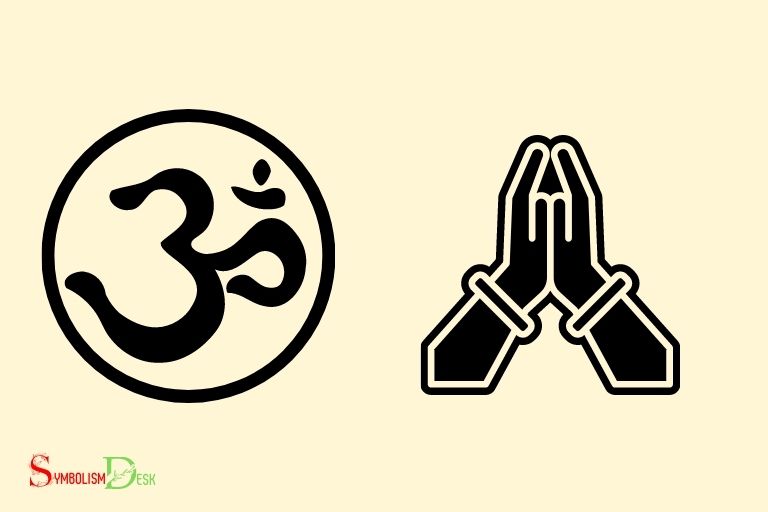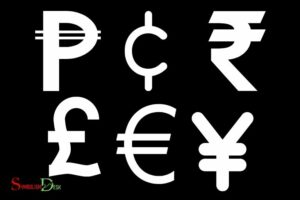What is the Namaste Symbol? Respect and Reverence!
The Namaste symbol is a gesture of respect and reverence, originating from Indian culture, where the palms are pressed together and the fingers point upwards close to the chest, accompanied by a slight bow or nod.
Namaste has its roots in ancient Indian culture and is derived from the Sanskrit word “namas,” meaning “bowing” or “adoration,” and “te,” which translates to “you.”
It is widely practiced in Hindu, Buddhist, and Jain cultures, as well as in various yoga and meditation practices worldwide.
The Namaste symbol acts as a non-verbal greeting, acknowledging the divine in others and showing humility.
The Namaste symbol is more than just a physical gesture; it carries profound spiritual significance.
It represents the belief that there is a divine spark within each individual, and by performing the Namaste gesture, we acknowledge and honor that divinity in ourselves and others.
This expression of respect and unity transcends social and cultural barriers, making it a universal symbol of love, peace, and spiritual connection.
5 Aspects: Namaste Symbol Meaning
| Namaste Symbol Aspect | Description |
|---|---|
| Meaning | Namaste is a traditional Indian greeting or gesture of respect. It is derived from the Sanskrit words “namaḥ” (to bow) and “te” (to you). The gesture symbolizes the belief that there is a divine spark within each individual, and paying respect to that divine essence. |
| Gesture | The Namaste gesture is performed by pressing the palms of the hands together, fingers pointing upwards, close to the chest, and giving a slight bow. |
| Occasions | Namaste is used as a greeting, a farewell, or to express gratitude. It is commonly used in yoga practice and meditation as well. |
| Cultural Significance | The Namaste symbol holds a vital place in Indian culture, representing respect, humility, and acknowledgement of the divine in others. It is also used in other South Asian countries like Nepal, Sri Lanka, and Bhutan. |
| Variations | The Anjali Mudra is a variation of the Namaste gesture, used in yoga practice to focus the mind and connect with the body. In this variation, the hands are placed together at the heart chakra. |
Key Takeaway

Five Facts About The Namaste Symbol
The Meaning Behind The Namaste Symbol
The namaste symbol is a well-known greeting symbol with its roots in hinduism and yoga. The word ‘namaste’ comes from sanskrit, where ‘namah’ means ‘to bow’ and ‘te’ means ‘to you’.
Namaste is a way of showing respect and expressing gratitude towards one another.
The gesture is typically made by bringing the palms of both hands together at chest level and bowing slightly. In this blog post, we will discuss the meaning behind the namaste symbol.
Understanding The Origins Of Namaste Symbol
The namaste gesture originated in india and is commonly used in hinduism. The gesture is a way of showing respect and acknowledging the inner light or divine spark within another person.
The gesture represents the belief that there is a divine spark in every human being, and by recognizing it in others, we honor the divine within ourselves.
The namaste symbol symbolizes unity, peace, and respect.
Interpretation Of Namaste Symbol Across Cultures
The namaste gesture is not limited to hinduism and yoga. The greeting is being accepted all over the world as a way of showing respect, gratitude, and welcoming. Its popularity and universality have led to its adoption in other cultures as well.
The gesture is often used in buddhism, jainism, and sikhism as a sign of respect. In some countries, such as thailand, namaste has become a standard greeting.
Namaste Symbol And Mindfulness – A Connection
Namaste has become deeply associated with mindfulness and meditation practices due to its roots in yoga and hinduism.
In recent years, mindfulness and meditation have gained wide acceptance for their stress-reducing and healing benefits.
Namaste is used in mindfulness and meditation practices to create a peaceful atmosphere that helps practitioners connect with their inner selves and find inner peace.
The namaste symbol is a perfect representation of the mindfulness practice as it symbolizes the recognition of the divine spark within oneself and others.
The namaste symbol has a deep meaning and significance in the hindu culture. Across the globe, its popularity as a way of showing respect and gratitude is increasing.
The namaste symbol, with its roots in yoga and hinduism, can help you connect with yourself and others, leading to inner peace and calm.
Depiction Of Namaste Symbol In Art
Namaste is a well-known greeting in the indian subcontinent, which is used with a folded hand gesture (or ‘mudra’) and a bow. The namaste symbol is an important part of indian culture, religion and is depicted in various forms of art.
In this blog post, we will explore the depiction of namaste symbol in different art forms.
Namaste Symbol In Yoga Art
Yoga is an ancient practice that originated in india. It has been practiced for thousands of years and is now popular all around the world. The namaste symbol is an integral part of yoga, where it is used as a greeting before and after a yoga session.
In yoga art forms, the namaste symbol is depicted in various forms, including drawings, paintings, and sculptures.
Some of the poses in yoga also incorporate the namaste symbol in their practice, making it a crucial element of this ancient discipline.
Traditional Depiction Of Namaste Symbol In Indian Art
Indian art has a rich culture and has been influenced by various religions and traditions. In indian art forms, the namaste symbol is depicted in various ways.
The most common depiction of the namaste symbol in indian art is through the mudra, where the hands are folded together with the fingers pointing upwards, close to the chest, or near the forehead.
In some indian art forms, the namaste symbol is also depicted with additional elements such as flowers, lights, and incense sticks that symbolize peacefulness, surrender, and love.
Namaste Symbol In Modern Art Forms
The namaste symbol has transcended time and culture. In modern art forms, the namaste symbol has been depicted in various ways, including paintings, sculptures, and digital art.
The namaste symbol represents a universal message of peace, love, and respect that transcends all cultures and traditions. It is a symbol that promotes harmony and unity among people of different backgrounds and beliefs. In a world where conflict and division are all too common, the namaste symbol serves as a reminder of our shared humanity and the importance of compassion. Its message of peace and respect is echoed in symbolic biblical names like Shalom and Agape, further emphasizing its universal significance.
Many artists now use the namaste symbol as a central theme in their artwork, using it to express messages of unity, harmony, and hope.
The namaste symbol is an important part of indian culture, religion and is depicted in various forms of art. The namaste symbol represents peace, love, and respect, which is why it has gained importance across the world.
From yoga art forms to modern art, the namaste symbol continues to inspire artists and individuals to connect with themselves and others in a more meaningful way.
Significance Of Namaste Symbol In Different Practices
Namaste symbol is a familiar word for those who are interested in yoga, meditation, or spiritual practices.
Namaste symbolizes a traditional indian gesture of respect towards others. The word namaste is derived from sanskrit. ‘namah’ means bow and ‘te’ means you.
In short, it means ‘i bow to you’. The gesture of namaste is done by folding hands together and placing them in front of the heart chakra.
The significance of namaste symbol varies in different practices. In this blog, we will discuss how namaste symbol is significant in different practices, including yoga, meditation, and spiritual practices.
Namaste Symbol In Yoga Practices
Yoga is a well-known practice for balancing and energizing the mind and body. It includes various poses and breathing techniques that are helpful in maintaining good health. In this practice, namaste symbolizes respect towards the teacher and other students.
Here are some key points to understand the significance of namaste symbol in yoga practices:
- Namaste is often used before and after yoga class to express gratitude towards the teacher and other students.
- It is a way to connect with each other through physical and emotional body language.
- The gesture of folding hands together and placing them in front of the heart chakra creates a meditative mood and encourages concentration.
Incorporation Of Namaste Symbol In Meditation Practices
Meditation is widely practiced by people all over the world, and namaste symbol holds a significant role in this practice. In meditation, namaste symbolizes respect towards oneself and others.
Here are some key points to understand the incorporation of namaste symbol in meditation practices:
- In meditation, namaste is a way to connect with inner peace and calmness.
- Namaste symbolizes respect towards oneself and others and encourages self-love and acceptance.
- The gesture of folding hands together and placing them in front of the heart chakra helps in connecting with inner consciousness.
Use Of Namaste Symbol In Spiritual Practices
Namaste symbol holds a significant role in spiritual practices such as prayer and rituals. It symbolizes respect and gratitude towards the divine and others who practice spiritualism.
Here are some key points to understand the use of namaste symbol in spiritual practices:
- In spiritual practices, namaste symbolizes respect and gratitude towards the divine and others who practice spiritualism.
- The gesture of folding hands together and placing them in front of the heart chakra creates a sacred space and helps in connecting with the divine.
- Namaste is commonly used during prayer and worship, and it helps in creating a positive and peaceful environment.
Namaste symbol is significant in different practices such as yoga, meditation, and spiritual practices. It holds a significant role in creating a positive and peaceful environment and encourages respect, gratitude, and self-love.
The gesture of folding hands together and placing them in front of the heart chakra creates a meditative mood and helps in connecting with inner consciousness.
Namaste Symbol In Fashion And Jewelry
The namaste symbol is a traditional indian gesture that is used to express gratitude or respect. It has gained popularity around the world as a symbol of peace and tranquility. The symbol is often incorporated in fashion and jewelry, and it has become a trend in recent years.
Namaste Symbol In Traditional Indian Clothing
Traditional indian clothing such as sarees, salwar kameez, and anarkalis are often adorned with the namaste symbol.
Here are the key points to keep in mind:
- The indian culture believes that the namaste symbol brings positivity and good energy to the clothing.
- The namaste symbol is usually embroidered on the clothing in gold or silver thread to give it a royal look.
- The symbol is also used in printed fabrics, such as dupattas, to add a dash of elegance to the outfit.
Incorporation Of Namaste Symbol In Western Clothing
The namaste symbol has also gained popularity in the western fashion industry. From loungewear to casual wear, the symbol has found its way into the fashion industry.
Here are the key points to keep in mind:
- The namaste symbol is often incorporated in athleisure clothing to give them a spiritual touch.
- Western brands also use the symbol to show their appreciation for the indian culture.
- Some brands use the symbol in their logo, making it a part of their brand identity.
Popularity Of Namaste Symbol In Jewelry
Apart from clothing, the namaste symbol has also gained popularity in the jewelry industry.
Here are the key points to keep in mind:
- Namaste symbol jewelry is a hot trend among fashionistas and spiritual enthusiasts.
- The symbol is often used in bracelets, necklaces, and earrings to add an element of spirituality to the jewelry.
- Yoga enthusiasts also wear the symbol in their jewelry as it represents their practice.
The namaste symbol has become a popular trend in fashion and jewelry. From traditional indian clothing to western wear and jewelry, the symbol has found its way into the fashion industry.
Its spiritual connotation paired with its elegant design has made it a favorite among designers and trendsetters.
Does the Infinity Symbol Tattoo With Names Symbolize Respect and Reverence?
The popular trend of getting an eternal love tattoo with names incorporates the infinity symbol to symbolize respect and reverence. This meaningful tattoo speaks volumes about the everlasting bond shared with loved ones. By permanently etching their names alongside the infinity symbol, individuals showcase their unwavering devotion and eternal love. It serves as a constant reminder of the respect and reverence felt towards those whose names are immortalized on their skin.
FAQ On What Is The Namaste Symbol
What Is The Namaste Symbol?
The namaste symbol is a traditional indian greeting that represents respect and honor.
What Is The Origin Of Namaste?
Namaste comes from the sanskrit language and is a combination of two words: “namah” and “te. “
What Does Namaste Mean In English?
Namaste translates to “i honor the divine in you” in english.
How Is The Namaste Symbol Used?
The namaste symbol is commonly used as a greeting or farewell in yoga and other spiritual practices.
What Is The Significance Of Using Namaste?
Using namaste as a symbol or greeting acknowledges and honors the soul or divine being within each person.
Conclusion
The namaste symbol holds a deep spiritual meaning and is a way of showing respect and honor to one another. Its origin dates back to ancient india, and it has been practiced by many cultures around the world.
By joining hands in this manner and saying namaste, we connect with one’s inner self and the divine that resides within us.
It is a powerful gesture that can convey a sense of peace and love. Learning more about the namaste symbol and its significance can broaden our perspective and help us appreciate the diversity of cultures around us.
Its practice can bring peace and harmony into our daily lives, and it serves as a reminder to treat everyone with kindness and respect.
The namaste symbol is a beautiful representation of the unity and interconnectedness of all humanity. So, next time you join hands in this way and exchange namaste, remember the significance and embrace the beautiful meaning behind it.






